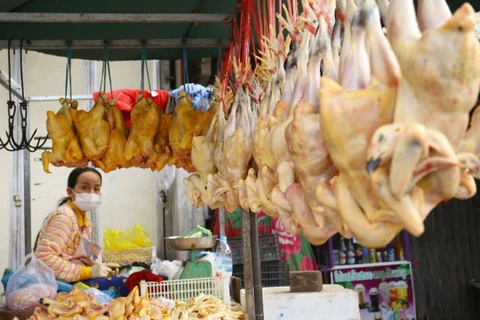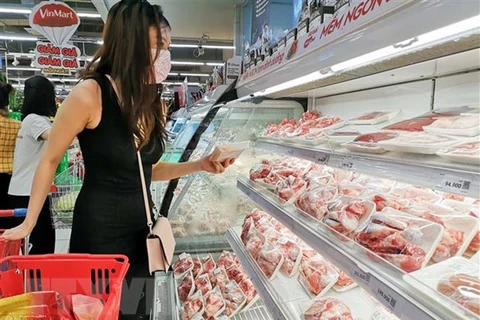 Higher food prices in the localities imposing social distancing under the Prime Minister’s Directive 16/CT-TTg have boosted the August CPI (Photo: VietnamPlus)
Higher food prices in the localities imposing social distancing under the Prime Minister’s Directive 16/CT-TTg have boosted the August CPI (Photo: VietnamPlus)So said Nguyen Thu Oanh, Director of the Price Statistics Department under the General Statistics Office (GSO), while pointing out some factors that affect the August CPI.
She noted the eight-month index rose by only 1.79 percent year on year, the slowest pace since 2016. The January - August core inflation inched up by only 0.9 percent.
Price hikes recorded in four of 11 goods categories
The GSO reported that the August CPI grew 0.34 percent in urban areas and 0.14 percent in rural regions compared to July.
Among the 11 categories of main consumer goods and services, four witnessed price increases, four with declines, and three with unchanged prices.
Of the groups with higher prices, food and catering services experienced the strongest price increase, 0.74 percent, contributing 0.25 percentage point to the overall CPI.
She attributed the rise to the fact that goods transportation and distribution have had to comply with strict procedures to meet anti-COVID-19 requirements, not to mention the surging demand for food stockpiling in the areas subject to social distancing.
The growth of 0.04 percent in the education category was driven by a 0.34-percent rise in stationery prices. Meanwhile, the index of the medicine and healthcare service category went up 0.02 percent partly because pharmaceutical prices climbed up 0.08 percent.
The transport category saw a month-on-month decline of 0.06 percent, mostly due to lower prices of new and used automobiles, down 0.09 percent and 0.84 percent, respectively. The index in postal and telecommunications services fell 0.05 percent as prices of smartphones, tablets, and their accessories respectively dropped 0.16 percent and 0.5 percent.
Continuing to bear the brunt of COVID-19, the category of culture, entertainment, and tourism continued to record a month-on-month decrease of 0.03 percent. Garment, headwear, and footwear posted a decline of 0.03 percent in their index as a result of shrunken consumer demand during the social distancing period.
Core inflation lowest in 10 years
That some provinces and centrally-run cities have practiced social distancing under the Prime Minister’s Directive 16/CT-TTg has led to stronger demand for food stockpiling. In addition, supplies are limited, and transportation costs have been soaring due to the strict imposition of social distancing, leading to difficulties in the flow of goods.
These factors have fueled the food price index’s growth by 0.97 percent from the previous month. In particular, prices of poultry meat increased 0.66 percent, eggs 10.28 percent, and fresh aquatic products 2.24 percent.
The August core inflation dropped 0.02 percent from July but rose 0.98 percent from the same period last year. During the first eight months, the core inflation grew slightly by 0.9 percent year on year.
Oanh stressed that the core inflation pace is slower than the overall CPI growth of 1.79 percent during January - August, indicating that consumer price fluctuations are mainly caused by higher food, petrol, oil, electricity, and gas prices. The core inflation in both August and the first eight months, compared to the same period last year, was lowest since 2011.
Facing the complex COVID-19 situation, under the Government’s directions, sectors and all-level authorities have actively implemented uniform solutions to curb the pandemic and stabilise prices in the market, the official added./.
VNA























